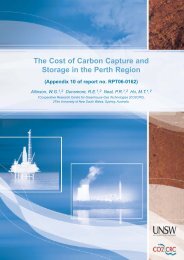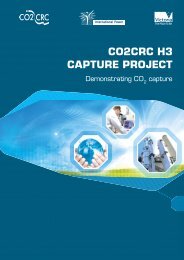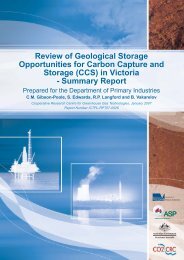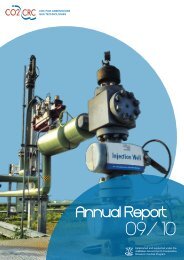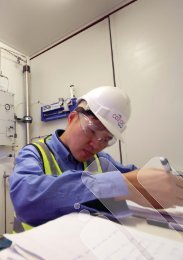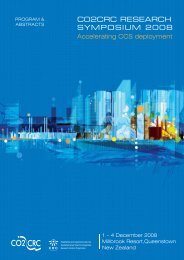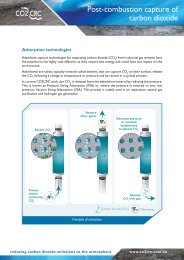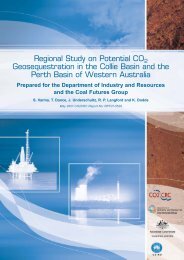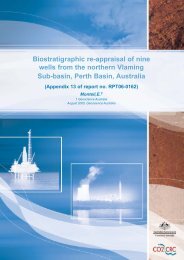Read the full report (PDF27.8 MB) - CO2CRC
Read the full report (PDF27.8 MB) - CO2CRC
Read the full report (PDF27.8 MB) - CO2CRC
Create successful ePaper yourself
Turn your PDF publications into a flip-book with our unique Google optimized e-Paper software.
Western Part of Basin<br />
Glamorgan-1 is <strong>the</strong> deepest of only a few wells drilled into <strong>the</strong> western Clarence–Moreton Basin.<br />
The well intersected five metres of sandstone at a depth of 875 m (KB). Tuff fragments within <strong>the</strong><br />
sandstone indicate a high potential for reactivity with a CO 2 fluid (i.e. <strong>the</strong>y are prone to diagenetic<br />
alteration, which reduces injectivity). The area has high reservoir risk and negligible potential<br />
storage volume. Reservoir quality does improve to <strong>the</strong> west (Thompson, 1987) and into <strong>the</strong><br />
adjoining Surat Basin. However, <strong>the</strong>se potential reservoirs are relied upon heavily to supply<br />
substantial quantities of ground water for irrigation and <strong>the</strong>refore cannot be used for CO 2 storage.<br />
Sou<strong>the</strong>rn Highlands Queensland<br />
In this basin conventional gas was intersected at a depth of only 580 m, where <strong>the</strong> coal rank is low.<br />
Russell (1994) suggested <strong>the</strong> source of <strong>the</strong> gas was <strong>the</strong>rmogenic migrating from a mature deeper<br />
source. This implies vertical migration and minimal long term sealing potential in <strong>the</strong> deeper<br />
section. In addition, sample analysis shows <strong>the</strong> porosity of <strong>the</strong> main reservoir interval to be less than<br />
7% (Thompson, 1987). As mentioned above, low porosity and permeability reservoirs are still being<br />
evaluated for <strong>the</strong>ir potential as CO 2 storage sites.<br />
New South Wales<br />
Petroleum exploration to date (12 wells) has targeted various intervals and has failed to prove even<br />
very small hydrocarbon volume potential (< 30 BCF). Sandstones in this part of <strong>the</strong> Clarence–<br />
Moreton Basin are very lithic and <strong>the</strong> fluvial depositional environment indicates high potential for<br />
laterally discontinuous seals (i.e. likely upward migration). Reservoir analysis estimates porosities<br />
of less than five percent and permeabilities of less than 10 mD. The sandstone generally has a high<br />
lithic content, including feldspars, carbonates, chert and volcanics. Some of <strong>the</strong> best porosity<br />
measurements originate from <strong>the</strong> Walloon Coal Measures sandstones which have a clay dominated<br />
matrix and no overlying sealing unit.<br />
Clarence–Moreton Basin – Summary<br />
The present dataset is not extensive enough for a detailed CO 2 storage assessment of <strong>the</strong> basin,<br />
however <strong>the</strong> data that does exist suggests that overall <strong>the</strong> Clarence–Moreton Basin has a high<br />
reservoir risk with unproven to leaky seals. The Ma Ma Creek seal, considered <strong>the</strong> most reliable<br />
(O’Brien et al., 1994), has internal lithologies from which a reading of 11.2% porosity was<br />
measured (Thompson, 1987). This reading exceeds <strong>the</strong> porosity of most sandstone reservoirs in <strong>the</strong><br />
Clarence–Moreton Basin.<br />
The GEODISC project stated <strong>the</strong> Clarence-Moreton Basin has good potential to hydrodynamically<br />
sequester large volumes of CO 2 within <strong>the</strong> Ripley Road Sandstone (Sou<strong>the</strong>rn Highlands Queensland<br />
and New South Wales, Bradshaw et al., 2003). However reservoir quality of sandstones in this basin<br />
is generally poor, but erratic and leaky faults pose a significant containment risk – highlighted by<br />
<strong>the</strong> discovery of gas in fractured basalts at a depth of 580m.<br />
3.1.5. Nambour Basin.<br />
The Nambour Basin shown in figure 3.1 has little potential for CO 2 storage because of <strong>the</strong> shallow<br />
depth and absence of suitable seals. The basin is poorly explored, with a total sediment thickness<br />
of approximately 500 m (Day et al., 1983). Storage volume would be comparatively low with<br />
comparatively high risk as <strong>the</strong> CO 2 would be stored at sub-critical temperatures and pressures<br />
without a regional seal to prevent vertical migration. The Nambour, Moreton and Maryborough<br />
basins were interconnected during <strong>the</strong> Early Jurassic (Day et al., 1983) suggesting that a sequence<br />
stratigraphic model incorporating data from all three basins may possibly indicate areas useful for<br />
niche CO 2 storage opportunities. “The Nambour Basin has no potential to sequester CO 2 from ei<strong>the</strong>r<br />
major or minor sources” (Bradshaw et al., 2003).<br />
12


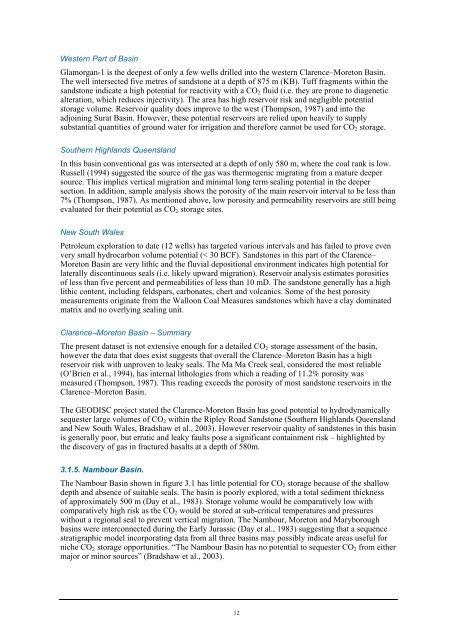
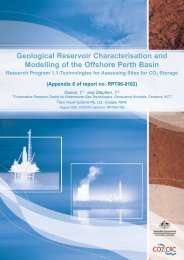
![Post-combustion solvent absorption [PDF 438KB] - CO2CRC](https://img.yumpu.com/48575763/1/184x260/post-combustion-solvent-absorption-pdf-438kb-co2crc.jpg?quality=85)

